One thing about being in a constant state of new travel experiences is that a new adventure starts as soon as the last one ends. It is difficult to make the time or have the perspective to write about an adventure while you are in it, but if you wait until after it is over, the next adventure has already begun and the last one seems like old news.
For example, here I now sit in the magical small city of Taxco, a few hours outside of Mexico City, on the rooftop of our rented villa overlooking the white and red layered rooftops of a densely populated Centro and the lush, steep, green mountains spotted by cloud shading in the background.
This is a city of mystery, begging for each little hidden walkway and alcove to be explored. The main roadways made of black, slippery pieces of stone are barely wide enough for a single VW bug as they wind their way up the hills between buildings to the center of town. These roadways are supplemented by 1000’s of public stone stairways and cement paths around every corner, leading through even narrower passageways bound by stone walls on both sides, interrupted by an occasional offshoot in another direction or a small window out of which a young woman sells groceries. We have over six weeks here with three other sailing friends while studying Spanish in an 16th century ex-hacienda owned by the Mexican national university. I must remind myself, however, that this is the subject of another blog post, not this one!
Nevertheless, this was such a marvelous sailing season that it really deserves a recap. It was the sailing season we had been waiting for ever since Cool Change brought us to Mexico in 2014. Finally, we got to go almost everywhere we had hoped for, even with a few unplanned interruptions in between. Of course, we felt we didn’t have enough time – even after several days in one spot, which happened rarely, we weren’t ready to leave and had to force ourselves to move on so we could take in as much as possible. This was especially important considering that if everything continues to fall into place, we will have sailed Cool Change to French Polynesia by this time next year, leaving our beloved Mexico behind until we can get back to her several years from now. So this was the last chance, for the foreseeable future, to experience Mexico by sailboat.
We managed to sail all the way down to Zihuatanejo from Mazatlan on the Pacific Coast of Mexico and then across to the Sea of Cortez, up as far as Santa Rosalia, and then back down and across to Mazatlan. All in all, we sailed 2418 nautical miles (nm) this season. That sounds like a lot or a little based on your perspective, but for us, it represented our biggest sailing season yet. You have to remember, we sail an average of only about five nm per hour under normal conditions. And for the most part, we tried to anchor within 20 to 30 nm of our last anchorage to arrive well before dark. (That is one thing that is great about both the Pacific Coast of Mexico and the Sea of Cortez where we visited – anchorages exist close enough to each other that there are few really long sailing days unless you choose them). We dropped anchor 51 times, sometimes at the same place twice at different times in our journey, and we entered a marina nine times, each for one or more days.
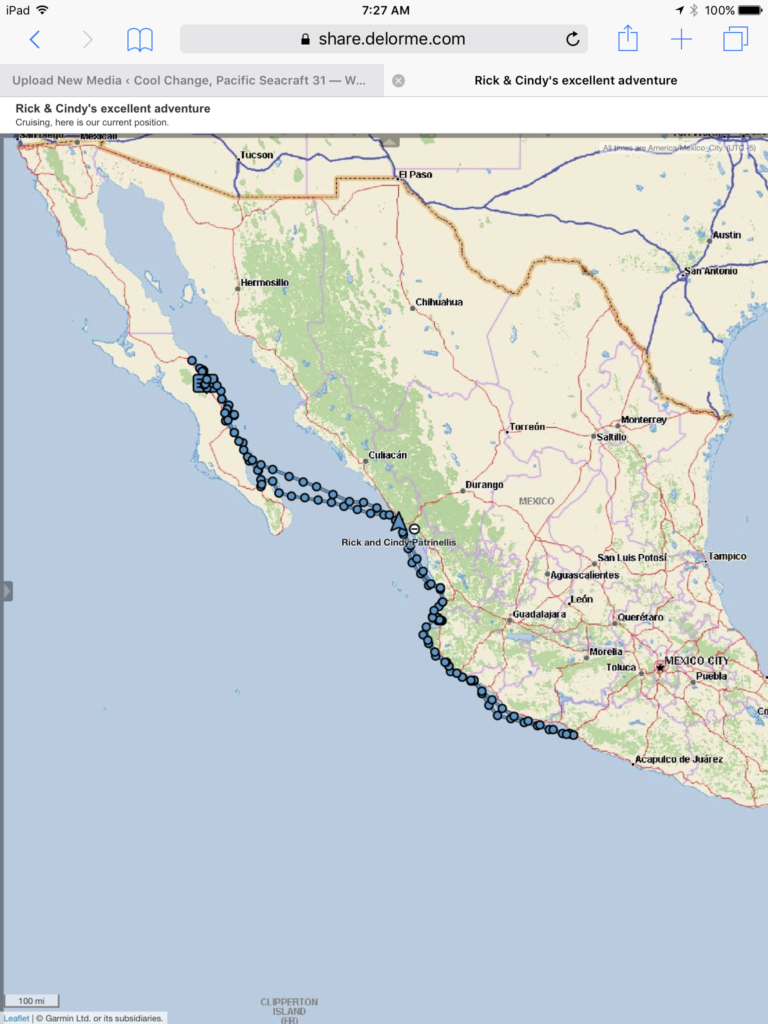
Our 2017 sailing track, from Mazatlan down to Zihuatenejo and then back up to Mazatlan, across the Sea of Cortez, up as far north as Santa Rosalia, then back across to Mazatlan
When we first sailed down to Mexico, we couldn’t understand the folks who spent all their time “on the hook” (anchored) when there was a marina nearby, unless they had a really tight budget. In our case at least, being at anchor had meant we gave up certain conveniences: the ability to use some A/C devices, the use of hot water unless we ran our engine, facilities to comfortably stand in while showering, access to ice for our nightly cocktail, access to laundry facilities, a stable platform for making repairs, and obviously, access to all the conveniences that marinas located in large towns provide, such as a dinner out and large stores for provisioning. Our justification for spending the extra money on a marina was that as a smaller boat, we had fewer of the conveniences on board compared to a larger boat but had cheaper slip fees than they did, so why not stay in a marina?
But during this season, Alleluia!, our perspective changed: we found ourselves dropping into marinas only when we absolutely needed to, and getting out of them as soon as we possibly could! We saved up the must-do-at-port jobs and then rushed to get them done so we could get out of the marina. Marinas became the occasional necessary evils in our travels, pining all during our marina stay for the moment we could get back out on the hook.
Why the change? Well, part of it was that, poco a poco, we made accommodations on Cool Change for most of what had been inconveniences. For example, we added a very small (200 watt) inverter so we could power and recharge our computers and run our mini-movie projector without A/C. That was a big deal for very little cost. Watching a recorded TV series that a friend gave us was a fun occasional diversion that wouldn’t have been possible without the inverter. As to hot water, we ran the motor due to light winds while underway enough that we nearly always had hot water, but in case we anticipated not having it, I had bought a stronger and more reliable sun shower that we would just heat up by setting it on the deck in the sun. The solar power is so reliable in Mexico during the sailing season that there is never any doubt it will give you what you need. As to showering, we actually grew to prefer showering on the boat even while in a marina – our shower flow is strong, it is far more convenient than having to get off the boat and walk to the shower facilities, and we have grown to enjoy sitting down while showering.
As to ice for our cocktails, the traditional vertical ice cube trays set next to the cold plate don’t fit in our refrigerator, and we have no separate freezer compartment, but this year I bought a whole bunch of disposable plastic bags that are specially configured with little pockets to make small ice cubes. I hang them vertically right next to the cold plate in the morning, and by nightfall I have just enough ice cubes for two cocktails each. They are perfect because the small size of the cubes helps them to freeze more quickly. Now if I could only find a reusable equivalent!
We found that we didn’t use nearly as many clothes while underway and on the hook as we did in the marina, so the lack of laundry facilities wasn’t that big of a problem. Clothing while underway is pretty minimal (shorts and a t-shirt) and the shorts can be re-used. Even when we dinghy to shore, no one expects anyone to be dressed up, considering we get there by jumping into the water and dragging the boat to shore. I hand-washed some personal apparel and maybe a few t-shirts once in a while and clipped them on the lifelines to dry in the anchorage, and they dried in no more than a few hours in the sun. Even when our bedding got wet because we left uncovered a hawse pipe leading to our anchor locker and then to the inside of the cabin during big seas, I was able to rinse out the seawater and hang the thick mattress cover outside. It dried by day’s end.
We even overcame the notion that we needed to be in a marina to do repairs. Of course, that happened by necessity. The worst case was probably when our toilet refused to flush. It was also the best case for why being at sea can actually be better than being in a marina for repairs! Before we could get to the cause of the problem, a part of a tie-wrap stuck in the toilet’s built-in macerator, we had to disassemble the toilet, which unfortunately had just been used for serious business. Cleaning it out was an extremely unpleasant mess. Being at sea allowed us to dispose of the mess overboard without breaking any laws – our organic waste mixed with the organic waste of all of the other ocean animals, instead of polluting an already-polluted marina. Along with making repairs underway, we also learned we could improvise if a part failed us. For example, we managed to accidentally drop the screwed-in oil dip stick cap while checking the oil as the dinghy sat in the water in an anchorage. Whoops! In spite of a friend diving for it, we couldn’t find it. A cork from a Grand Marnier bottle, along with some cleverly placed tie-wraps, kept oil from spurting out of the engine until we could find a replacement.
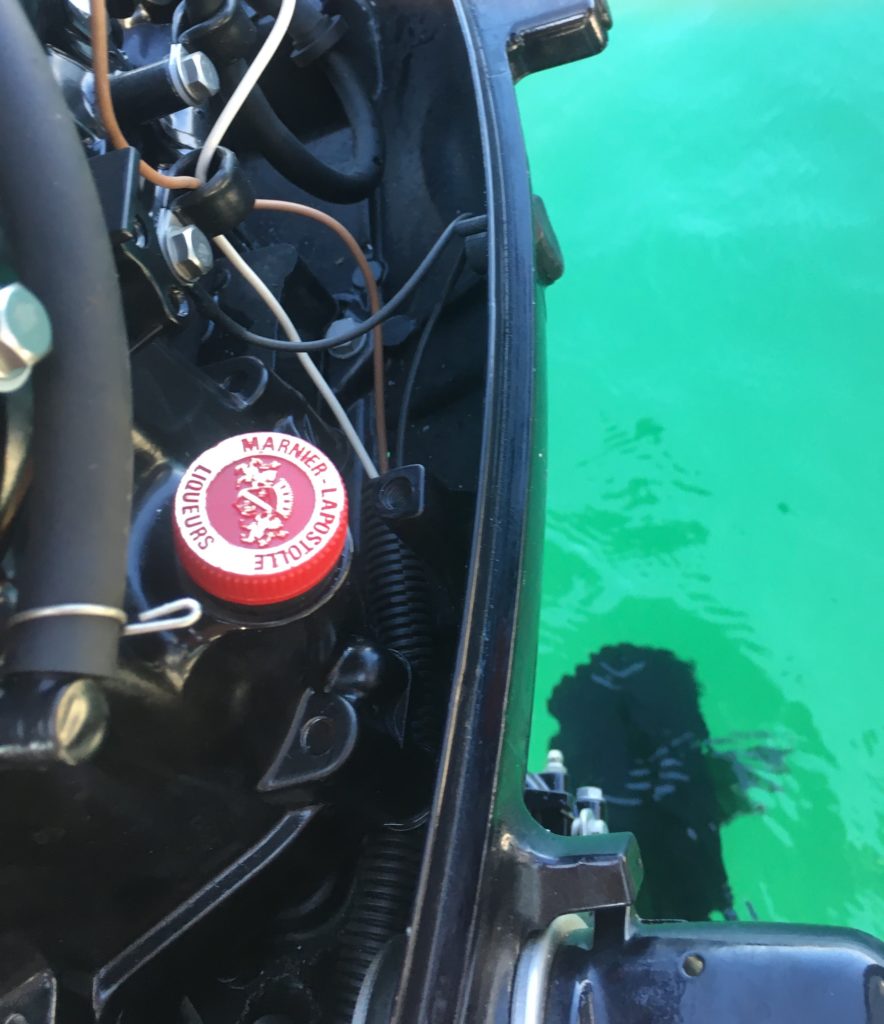
Improvising by using a Grand Marnier cork in place of an oil dipstick cap. I knew saving that cork would come in handy eventually!
As far as provisioning went, up in the Sea of Cortez at least, we found we could easily survive on the fish we caught supplemented by the fruits, vegetables, cheese and basic staples we were able to find in the smallest of stores in the smallest of villages, some of which were accessible only by sea. Everyone has to eat, for goodness sake, and many do not have the resources to get out of their small villages, so we could find what we needed in the most unexpected places.
Of course, don’t expect to find pesto, pickles or half and half, all of which are gringo foods, but you can get by without them, can’t you? Haha. I did find in one store in a large town, ultra-pasteurized half and half, which lasted several months and could be kept unrefrigerated until opened. Stocking up on our favorite gringo foods, or finding local alternatives, made it a lot easier to stay away from large grocery stores for longer periods. Toward the end of the season, I started using more canned meats, like chicken and tuna, to supplement the fish we caught, and I also discovered that Mexico has a plethora of brands of spicy, shredded, cooked meats that they soft package like tuna packages. They last for a long time unrefrigerated and they are tasty as either a filler for a taco or as a main meal combined with other ingredients. Finally, I started making my own yogurt using powdered milk, available everywhere in Mexico, and the last of the store-bought yogurt before it ran out. I also started making my own bread – Rick loved it and it was a cinch in the heat of Mexico as long as I kept the bulk yeast dry and refrigerated.
I am relieved that we overcame our addiction to marinas and large provisioning stores, because we won’t have either during the 30-45 day crossing of the Pacific next year, not to mention that both will be few and far between even after we arrive at our destination. Besides, we can save a lot of money without them, which may be necessary in the higher-cost cruising grounds of French Polynesia.
Another thing we learned this year was that we found it better to run the watermaker more frequently rather than waiting until the tanks were almost empty. At first we thought that it was best to run it less frequently because each run requires the use of about three gallons of just-made water to flush the system after use. But running it a little every day meant that we could even get away with using solar power to run the watermaker instead of having to rely on the engine, since the draw on our batteries could be restored by the end of the day if we only ran the watermaker for a little while. That made us feel more relaxed about taking all the showers we needed to without fear we would run out.
Of course my opinion is entirely subjective, but I think we became better sailors this season. We certainly both feel more comfortable in a variety of weather conditions, making decisions about what to do and how to do it. Setting up for sailing wing on wing has become something we can almost do blindfolded, we have the routine down so well. While flying our cruising spinnaker is not quite so routine, we have deployed and doused it several times with success. We have figured out additional sailing configurations beyond just full sails or reefing, that work for varying conditions: sometimes we sail just on the jib, sometimes we sail with just the jib poled out, sometimes we sail with the main and the staysail instead of the jib so we can sail higher, etc. Dropping the main without heading all the way up into the wind, by sheeting out the main and sailing on the jib, has become a practice of convenience when it used to be reserved only for difficult seas and winds. When our autopilot failed at night, we discovered that as long as there was a little wind to keep the mainsail full, we could use the Monitor Windvane even under motor power.
We have become more experienced with night sailing, and with understanding and responding to unseen objects or heavy traffic at night. We finally came across the ideal night watch schedule when there are just the two of us: 4 hours on and four hours off (10 pm – 2 am Cindy; 2 am to 6 am Rick). We have learned that there may be dangers posted out there with a radar reflector that are almost completely invisible at night – we just know to avoid them even though we can’t see them, like a fishing marker or a blinking light low to the water that appears much farther away than it is. We have dealt with approaching cruise ships and cargo ships and fishing vessels, some of whom are on AIS and we can call by radio if we feel it prudent, and some of whom are only detectable by radar or their bright lights. We know we can usually make it over long-line fishing gear as long as we are not in gear with the motor on, and we know to be aware of pangas that may signal a long line is near.
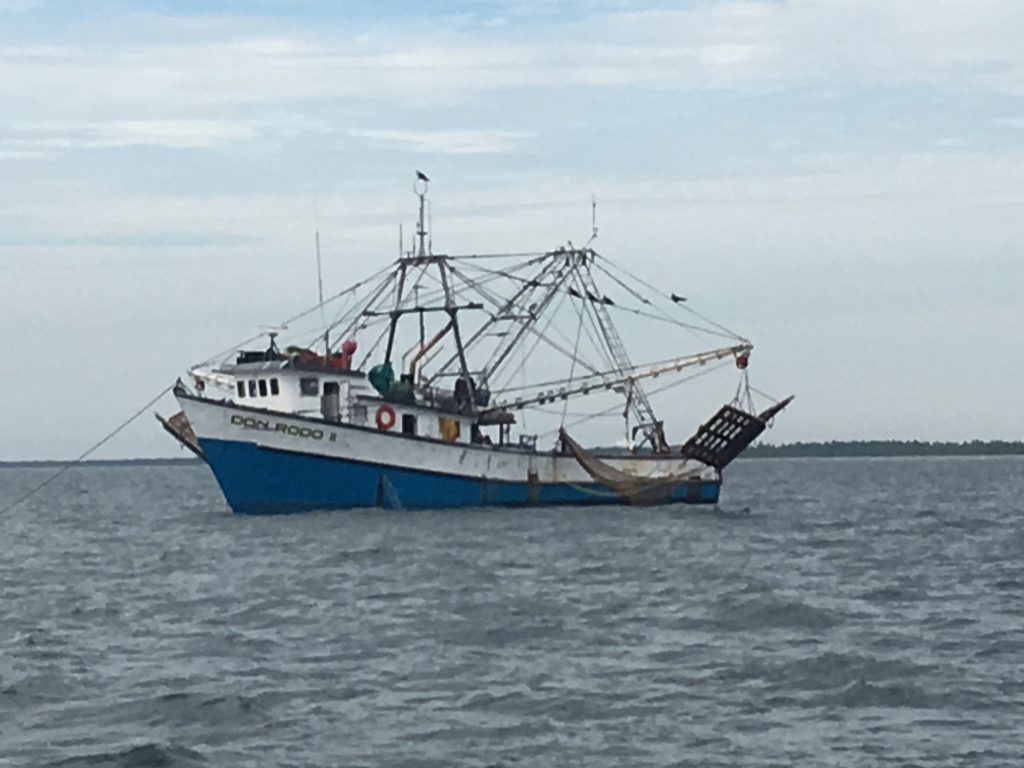
A shrimp boat during the day. At night they can be quite mystifying because they have no AIS and can only be seen by radar or their bright lights. Their course and speed are unpredictable.
Having anchored 51 times in this year alone, I think we are getting pretty good at working as a team to set the anchor, although I do believe we could benefit from switching roles more. Generally, Rick has been at the bow, handling the anchor and chain, while I have been at the helm controlling our direction and speed. We had to do this for most of the year because we weren’t able to come up with a solution to hang our new mantis anchor off the bow roller, so Rick had to physically pick up the anchor over the pulpit when we anchored and weighed anchor. I couldn’t have done that with sufficient confidence that I wouldn’t drop it because the anchor is so heavy.
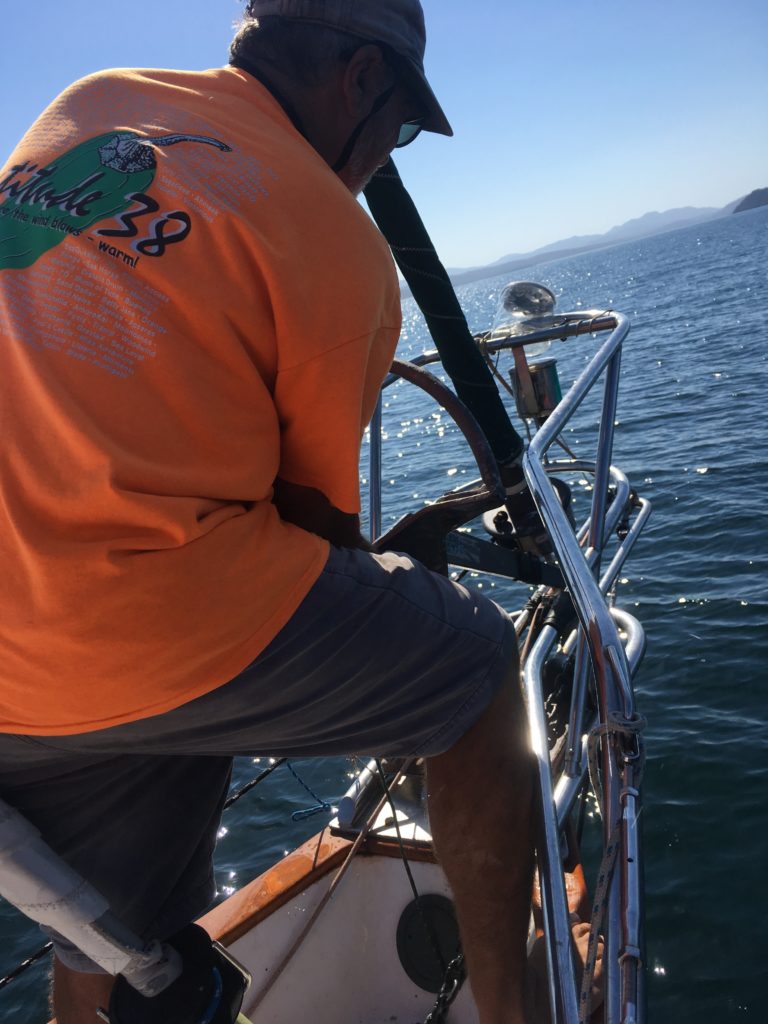
Rick manhandling the anchor to tie it down on the bow after picking it up over the pulpit and disconnecting the chain
But by the end of the season, we figured out that in all but the most challenging of conditions, we can indeed use the bow roller. That means that I could handle the anchor with just the foot controls for the windlass, and Rick could control the helm. Each job is different and I think it is important to know both, for better appreciation of the issues faced by the other part of the team, and also so that either one of us would be thoroughly comfortable in either role should one of us become incapacitated or otherwise unable. So we still have that to work on. But one of the things I adore about Rick’s approach to anchoring that I see so many other couples violate, is that he keeps his voice so low when communicating with me at the helm and him at the bow that he almost whispers; he never shouts. It makes for a much smoother process and a much better marriage! We also got to experience some 40 knot winds at anchor at night in San Everisto, where the boat would roll from side to side even though the wind and waves were coming from the bow, the seas outside were covered with mist, and the wave tops were all blown off, yet feel confident that Cool Change would hold her anchor.
Another huge improvement this year was Rick’s fishing prowess. He says that the most important thing he learned about trolling while underway this year is that the lure must have action. If it does, we catch fish; if it doesn’t, we don’t.
In addition, he bought a new rod and reel for fishing off the dinghy that has such better action than the cheap ones we had before, and a sailing friend of ours, Patrick from Voilá, turned us on to some new lures that have worked wonders. We have caught dorado, rooster fish, sierra, cabrilla, red snapper, and trigger fish, not to mention lots of other fish that we threw back, all year long, especially in the Sea of Cortez, mostly off the dinghy but some famously while trolling, such as the dorado.
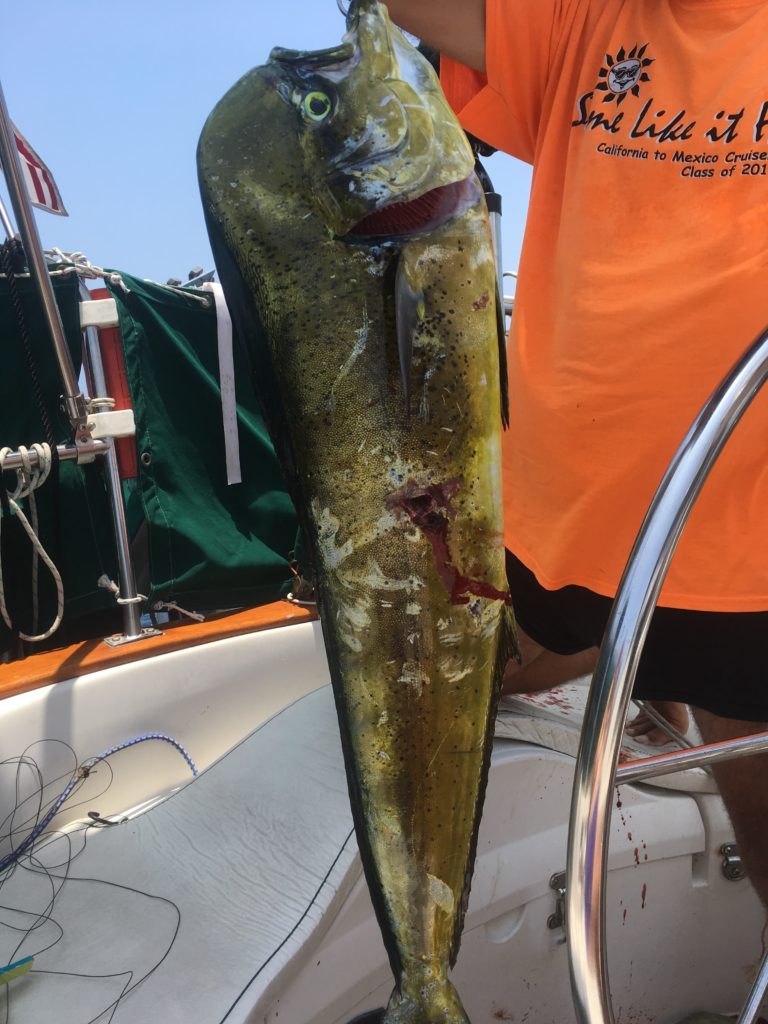
Our grand prize at the very end of the season, caught just outside of Mazatlan in June: an 11 pound dorado
Rick also had several sexy nibbles like one from a giant wahoo, but unfortunately it jumped way into the air and shook off the hook. Rick considers it to be both of us that are fishing, because I am there cheering him on in the exhilarating moments of reeling the fish in, I am there to take the rod at the critical moment when Rick gaffs the fish, and I clean and cook all the fish we catch. I am also the one driving the dinghy when he trolls or casts off the dinghy. And while it is true that I feel part of a fishing team, the few opportunities I had to catch a fish on our one reel and reel it in, were really exciting for me. I used to fish when I was younger and I would like to do it again if we can figure out how to both fish at the same time, at least front the dinghy. The most important thing, however, whoever does the fishing, is that we catch some good-tasting fish and get them to the table! Meanwhile, my repertoire of fish recipes has grown: sashimi, ceviche, fish tacos, sautéed or baked fish with various sauces, fish cakes … it feels more important to have lots of ways to avoid letting any portion of that meat go to waste when you personally took the fish’s life.
Many parts seemed to fail in Cool Change this season, and we could have been upset about it, but the way we looked at it was that we would rather it fail now and fix it than to have it fail in the middle of the Pacific Ocean. Our 17-year-old autopilot failed, so when my sister Kim and her husband Pete came down to visit, they brought a new one with them, and Rick replaced it. We took apart the head and fixed it, we took apart the shower sump pump and fixed it, we installed a new water heater, and we located the mysterious source of a nagging water leak. We replaced the steaming light that failed with a new LED bulb that Rick had the foresight to purchase before we needed it.
On top of it, this season I got to walk places I was unable to see the previous year before I got my hip replaced. What a blessing that was. And Rick got to take advantage of cheaper (and equal to higher quality) dental services by getting a tooth pulled after it cracked down to the root and became infected. He has also arranged for an implant next season.
While the snorkeling opportunities weren’t as plentiful as we hoped, we did get a chance to see “aquarium fish” in their natural habitat in a number of remote anchorages, and got more comfortable snorkeling. And we got the chance to visit some very special places, including Zihuatanejo, and much more of the Sea of Cortez. The Sea is not for everyone – some people just think of it as a desert with water around the edges. But I absolutely adored how isolated it was, how we could dive off the boat in the hot midday sun into 80 degree water and just float to our heart’s content in clean, unpolluted water, how welcoming and friendly the small villages were, and how much fun it was to fish there.
Last but not least, we found ourselves much more connected with the cruising community this year than in seasons past. A testament to that fact is that we are now sharing a villa for six weeks with Nancy from Aldabra and Julie and Jeff from El Gato, two boats we met at Barra de Navidad much earlier in the season. We went from not knowing anyone in the anchorage or marina last year, to struggling to find some time alone with just the two of us whenever we were in a popular anchorage! We feel like we have made some lifelong friends, no matter where the future seas take us.
This sailing season was exactly what we had hoped and planned for in so many ways. When we started down the coast of California on this adventure, we had so much to learn about sailing, about Cool Change, and about living aboard before we crossed an ocean. We had hoped that a few years’ experience would help fill in the gaps in Cool Change’s outfitting, our boat handling, and our management of the whole lifestyle. That is exactly what this year accomplished. And besides, we had a ball!
Several of the More Memorable Photos from the Season

The unbearably sad, premature death of our great nephew, the funeral for whom we sailed all night in difficult seas to get back to the States in time
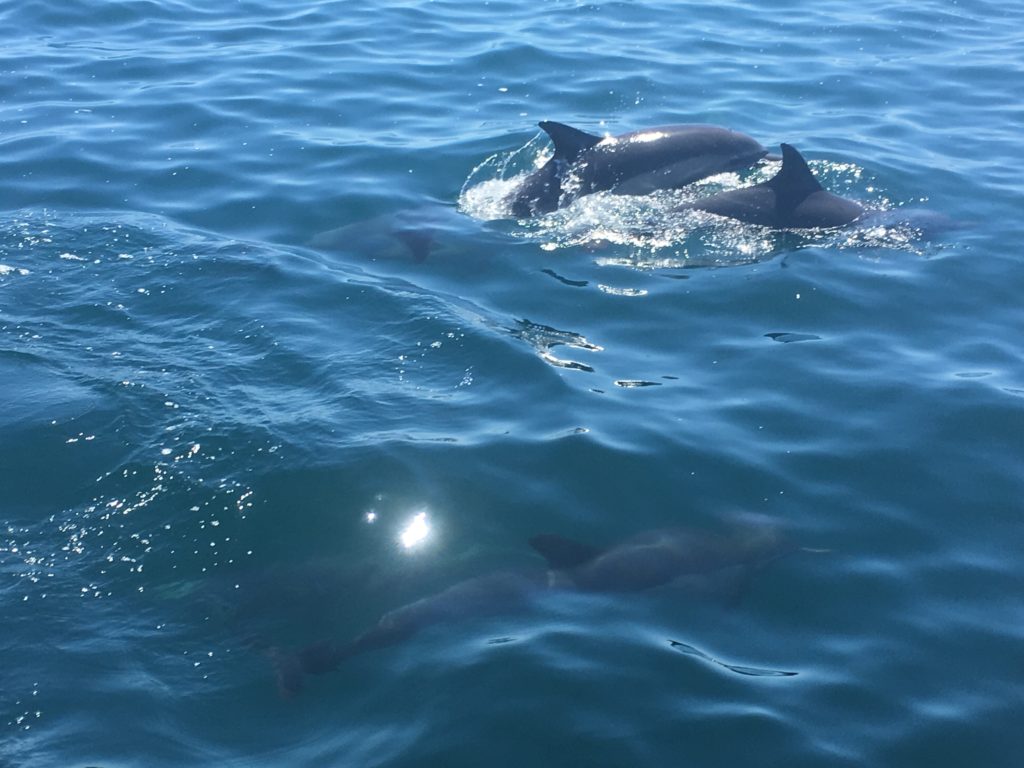
Dolphins, dolphins and more dolphins. In the Sea of Cortez, we came upon herds of thousands of dolphins more than once, and we were constantly being greeted by the resident dolphin families in each bay we entered
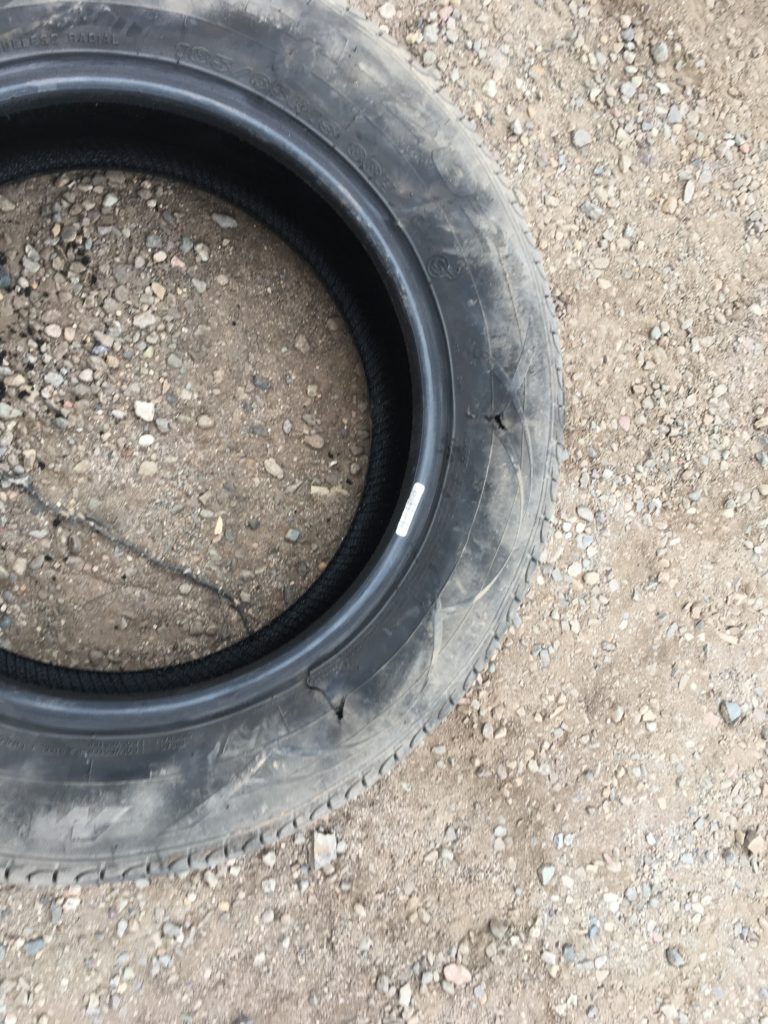
One of the two flat tires we acquired simultaneously in one of our two trips up the Baja Peninsula to the States by road we took this season. One trip was planned, the other wasn’t.
Here is a video of a Dolphin encounter we had in Bahia Santa Inez right after we left the anchorage of Punta Chivalo. These same Dolphins visited us the day before on our way into the anchorage.
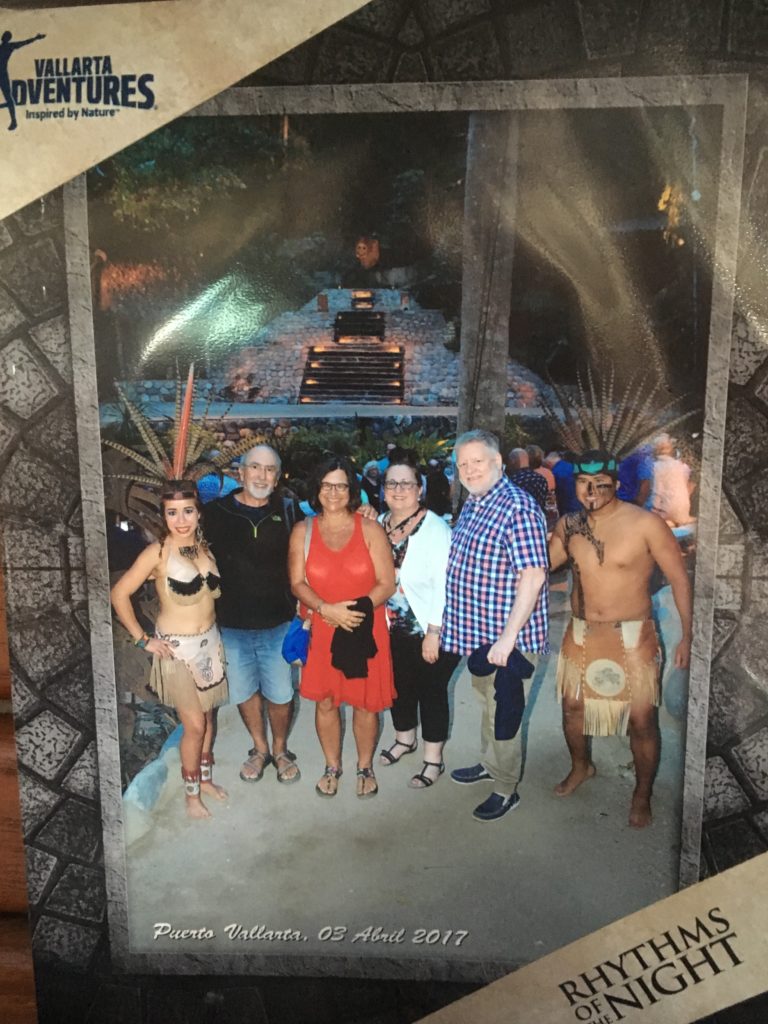
And the requisite photo of our fun Rhythms of the Night evening, here shown with my brave Brother in Law, Kim’s husband, who set aside his serious medical issues to come enjoy Mexico with us
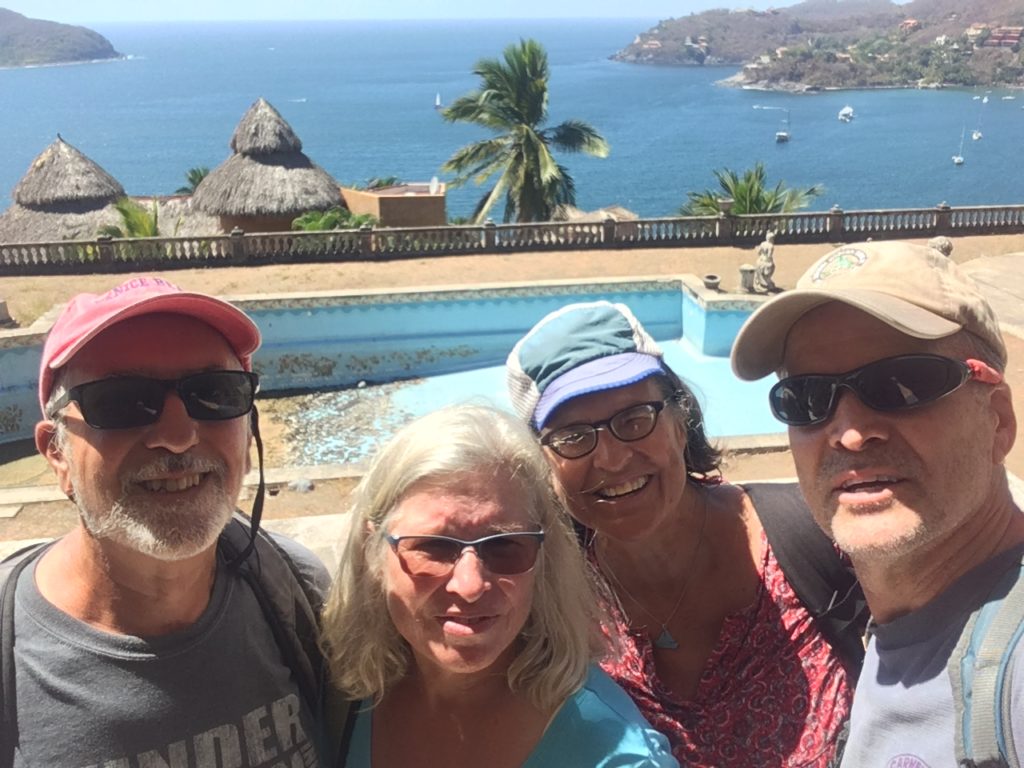
Our friend Derek from our dancing group in Sacramento, coming to Zihuatenejo to crew for our friend Nancy for a month
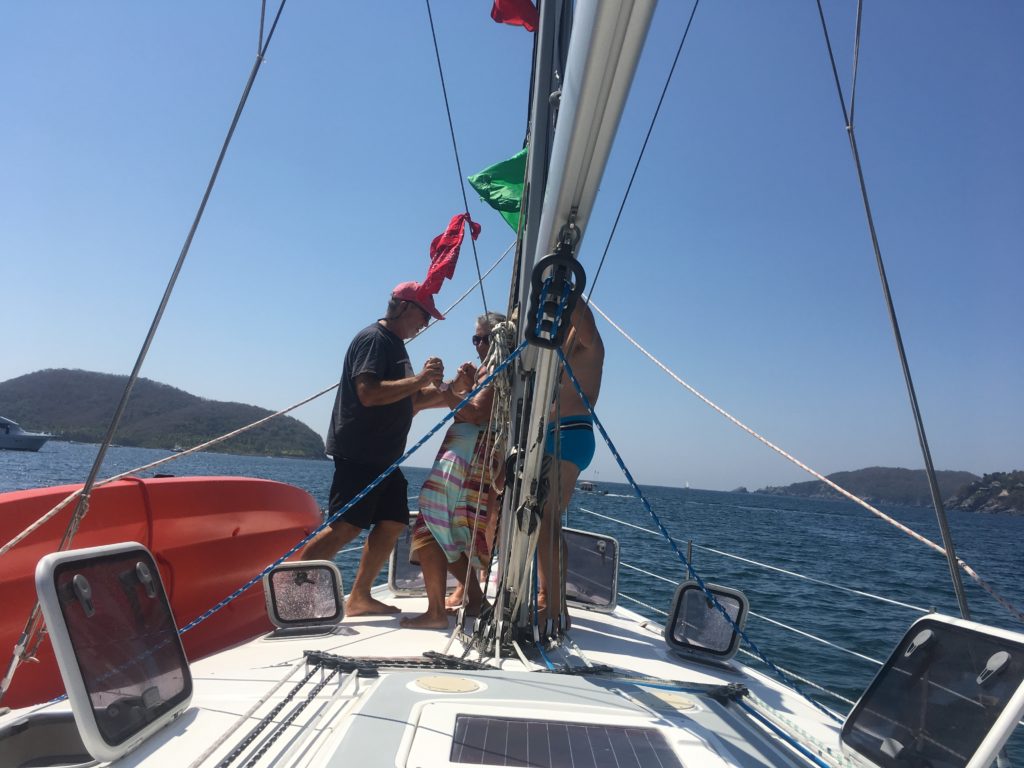
Rick teaching the French tourists salsa dancing on the deck of our friends’ Phil and Deslie’s boat while on a fundraising cruise for the Zihuatenejo Sailfest, which raises money for local school construction

Our friends Phil and Deslie from Wind Dancer. They came down to Mexico with the Baja HaHa the same year we did, in 2014. We spent a lot of time with them in Zihuatenejo. They are selling their boat so we will miss them in the anchorages, but they have bought a place in Nuevo Vallarta so they will still be around!

The dinghy dock in the Puerto Escondido mooring field on the Baja Peninsula – always crowded because Puerto Escondido is one of the few marina-like facilities along the Baja.
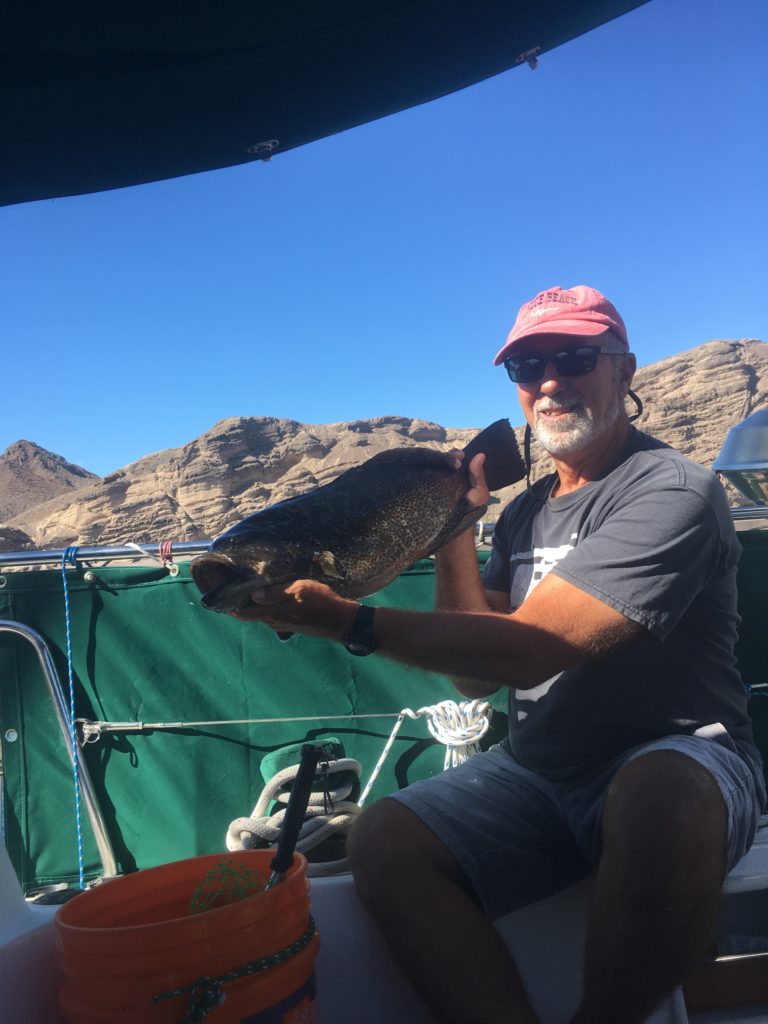
Rick’s 8 pound cabrilla, caught in Bajia de Cobre along the east side of Isla Carmen in the Baja cruising grounds
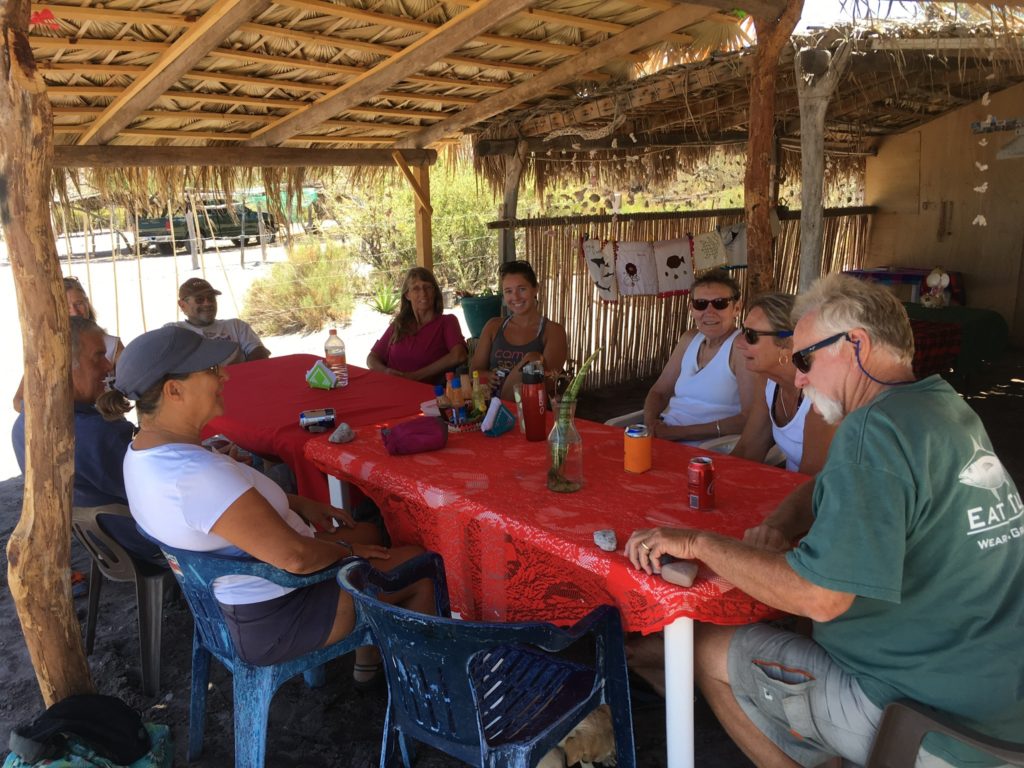
A group of cruisers gathering at the Brisa Del Mar restaurant, the only restaurant on the beach in the Agua Verde anchorage

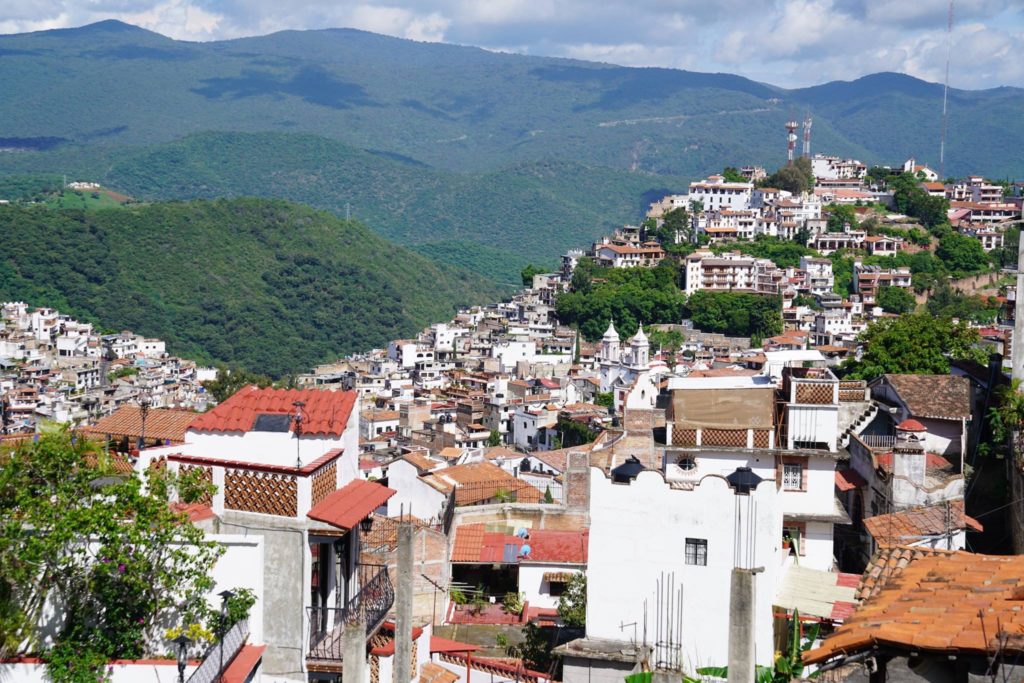
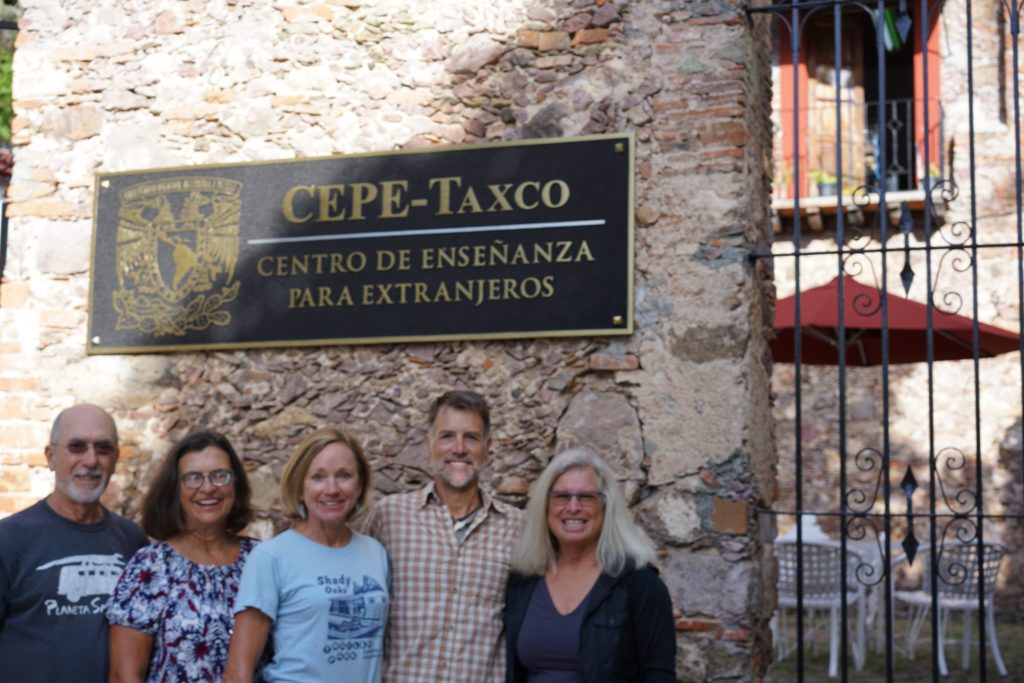
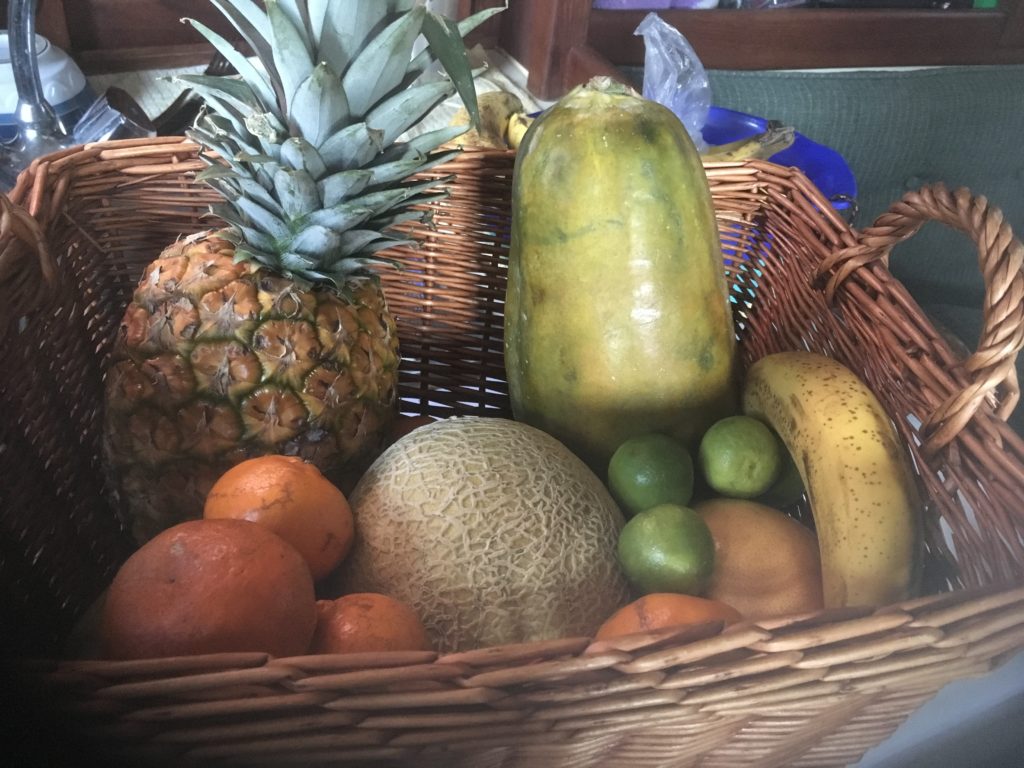
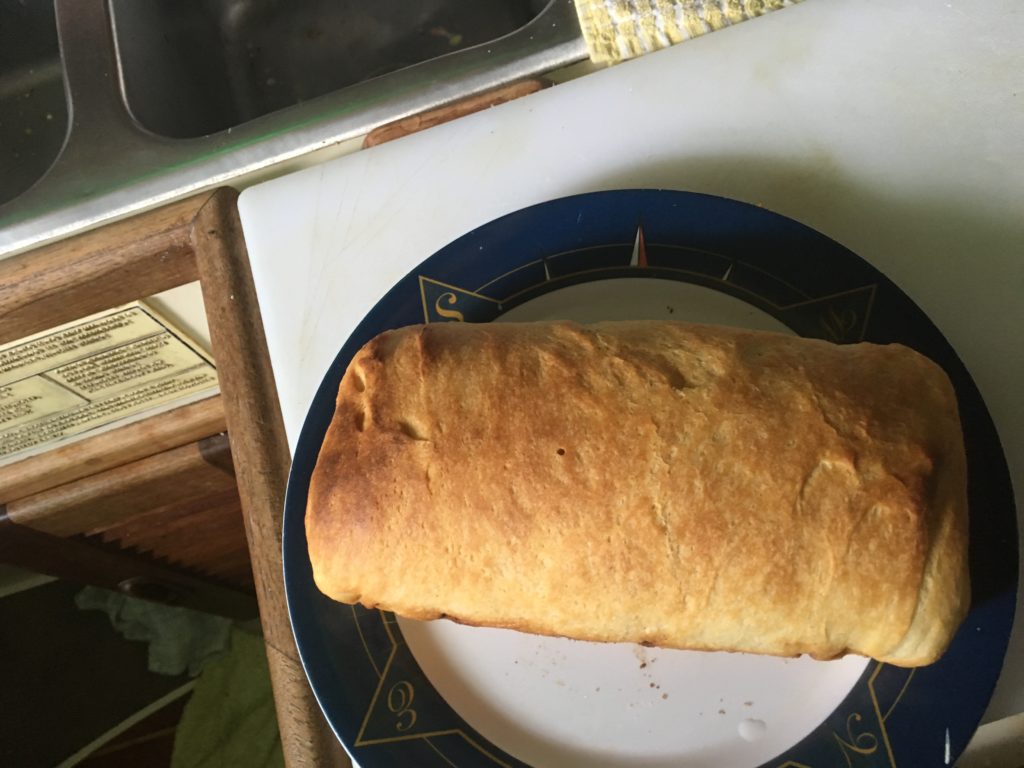
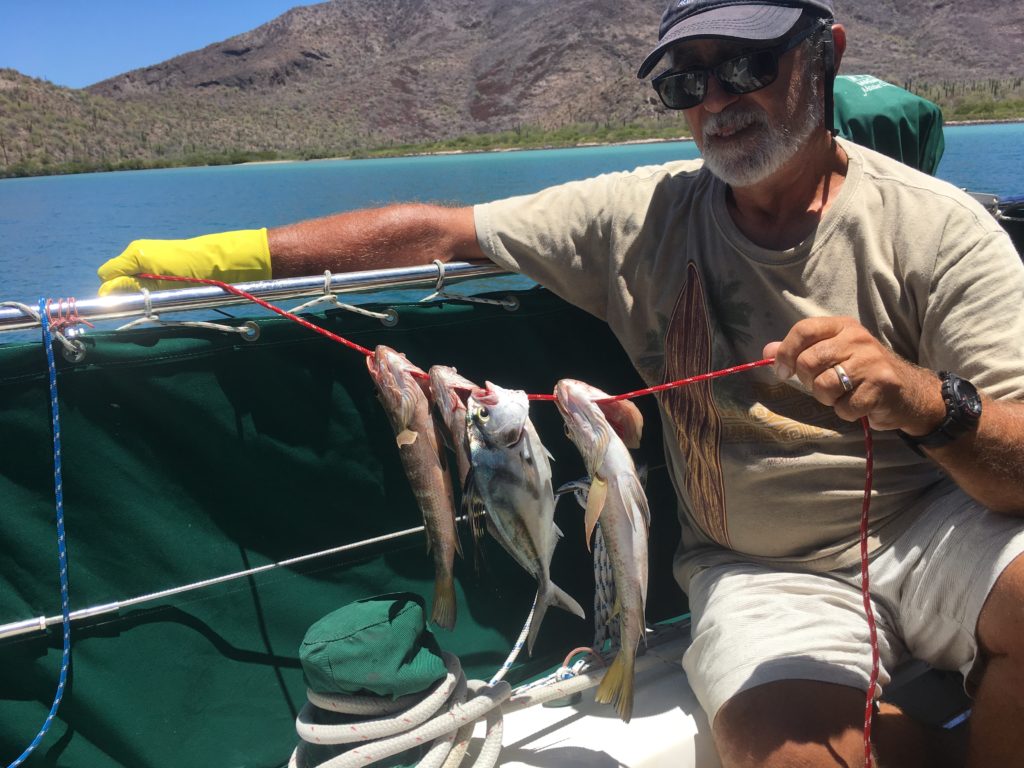
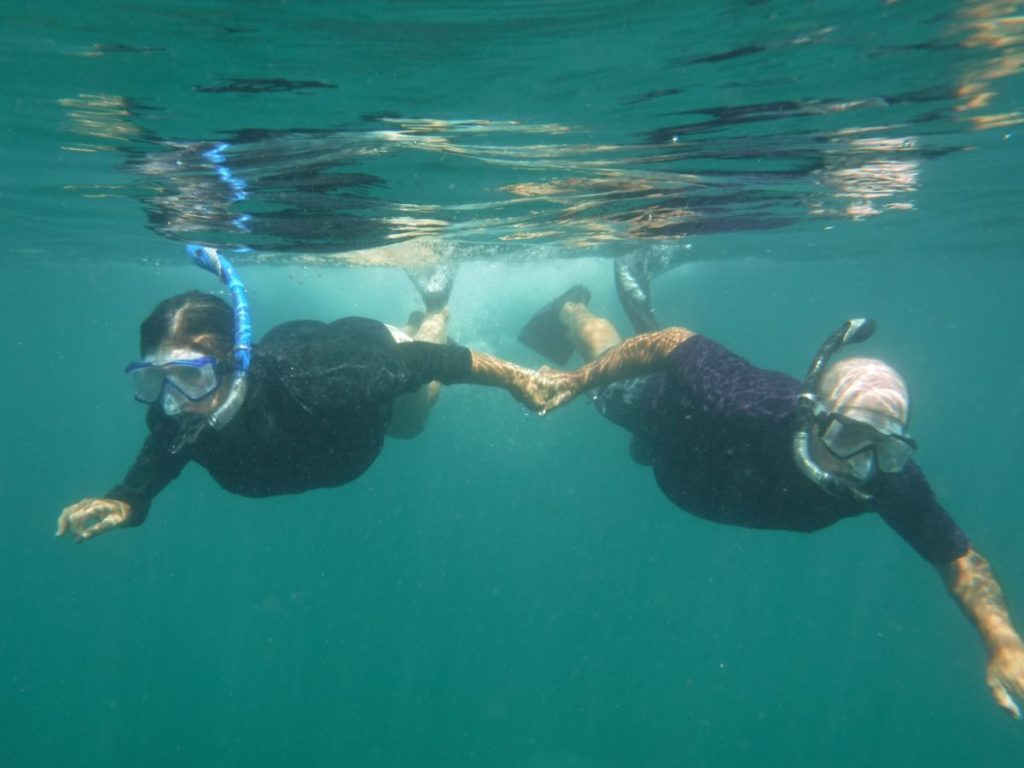

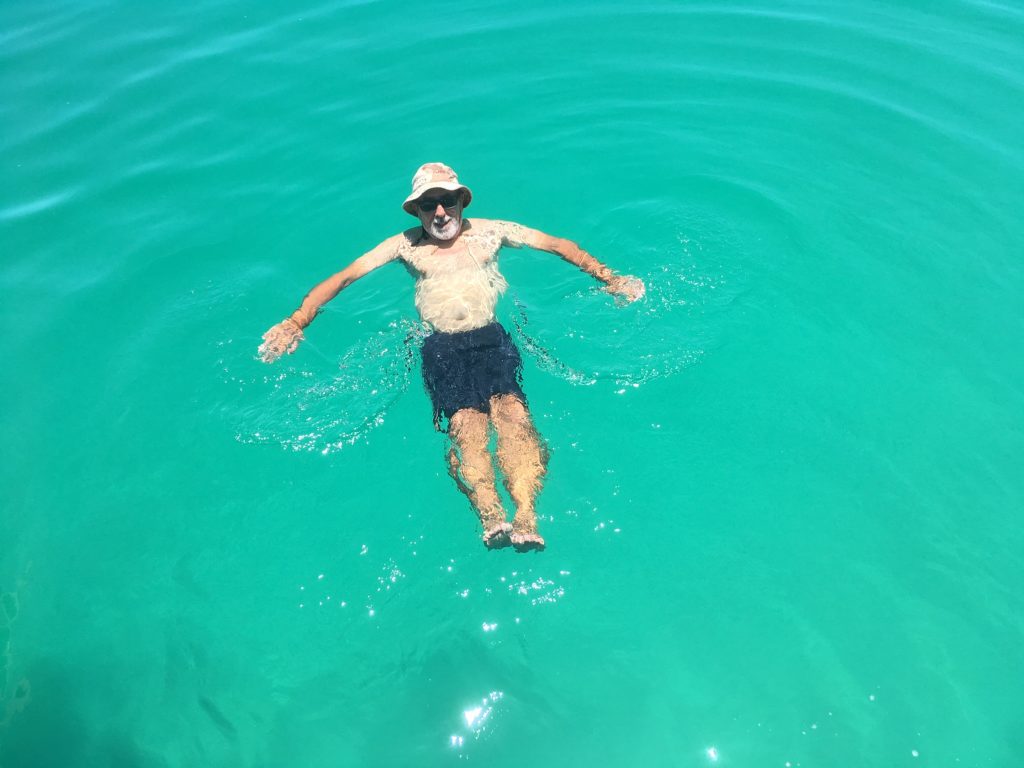
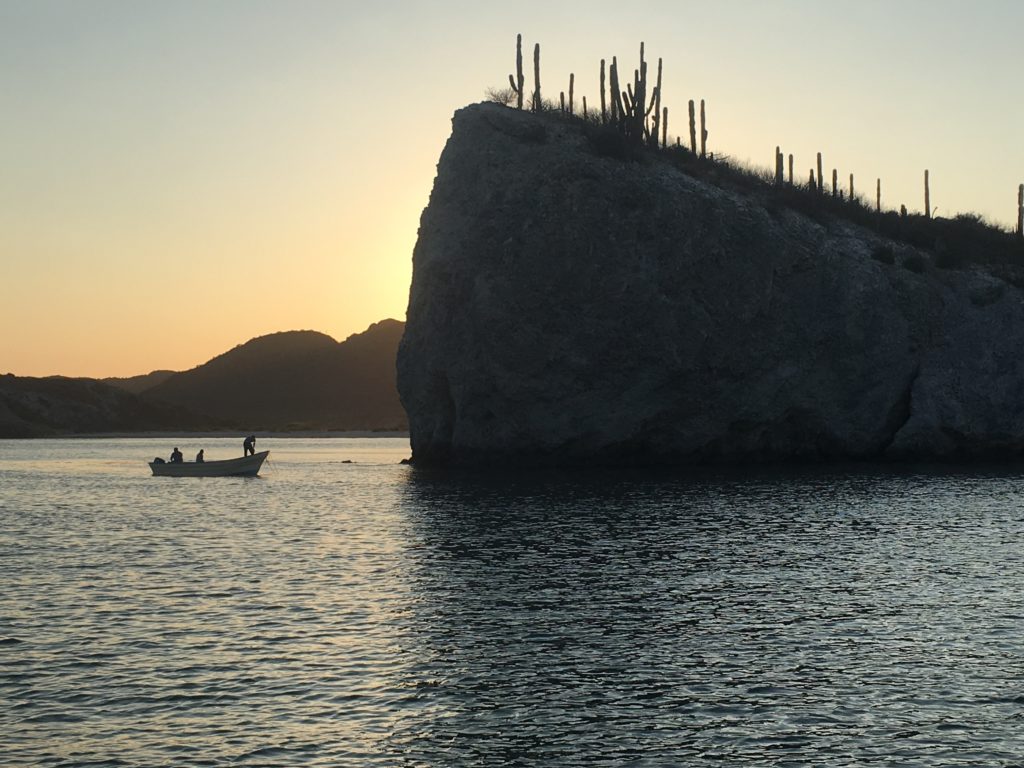
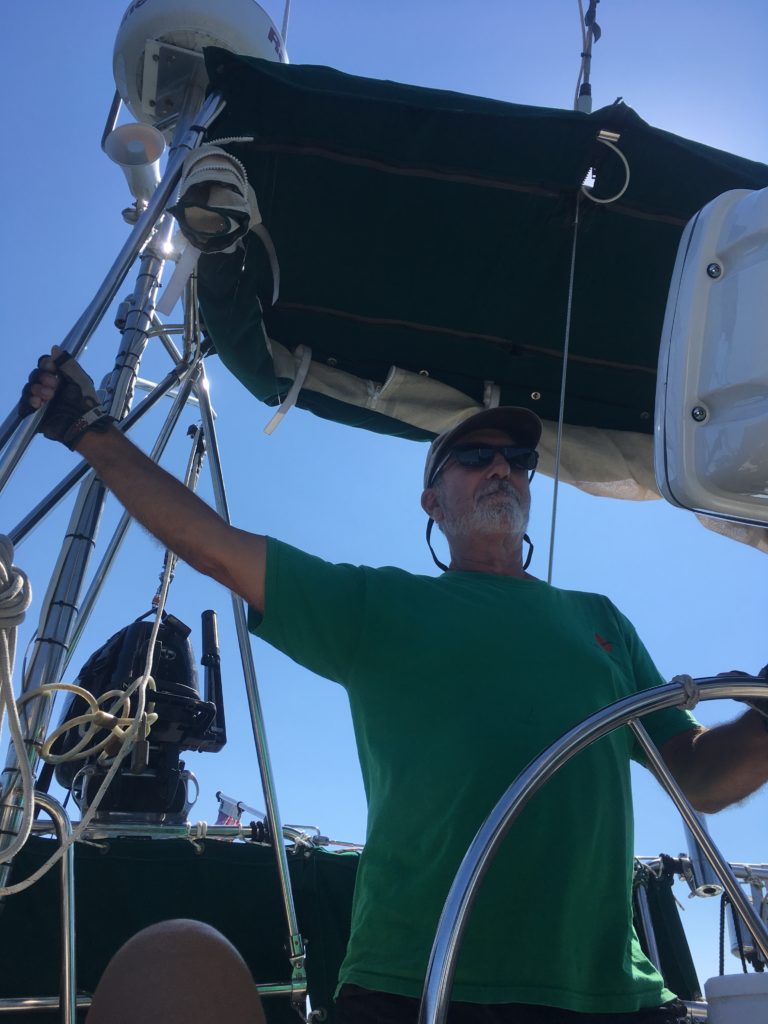

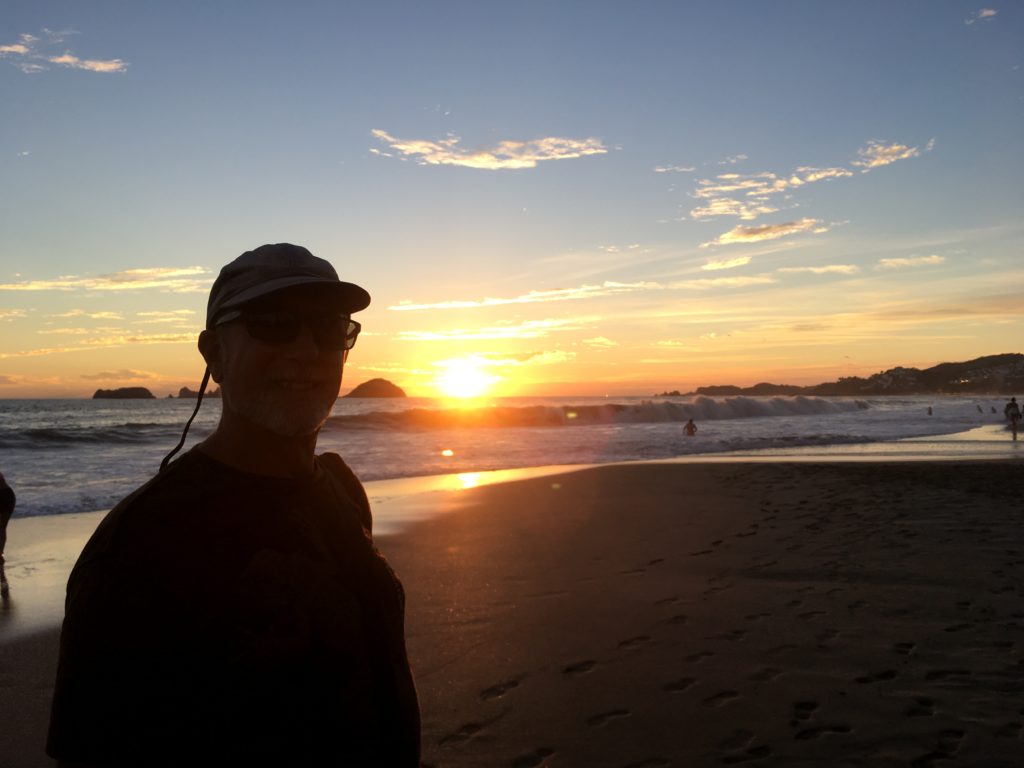
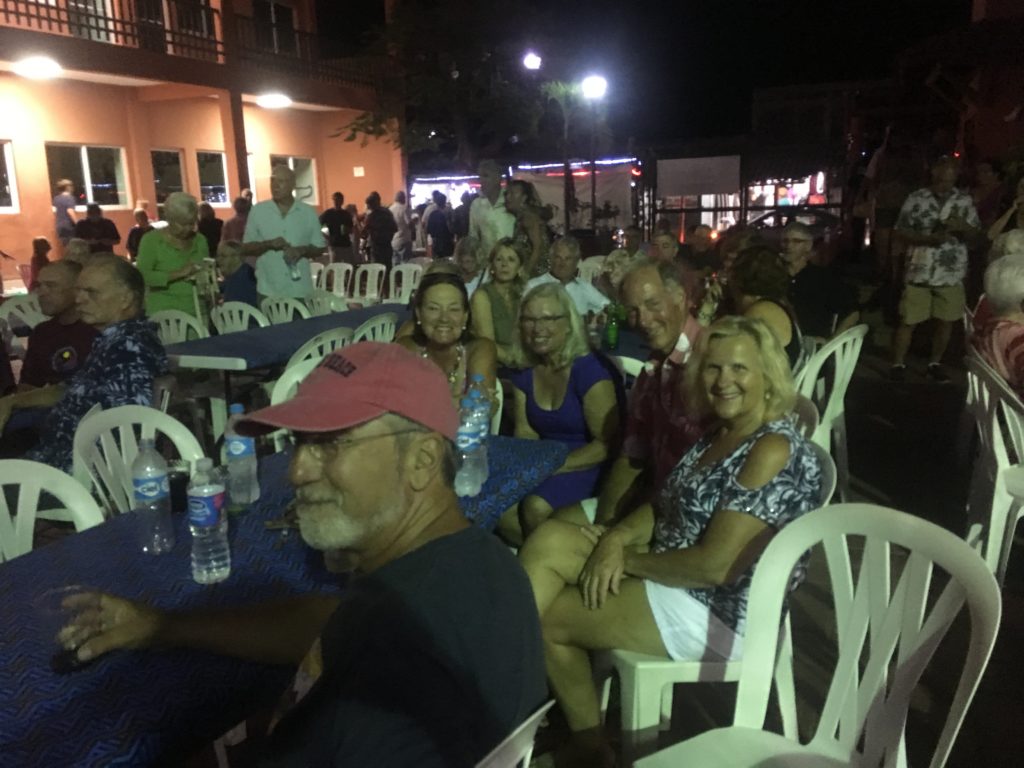
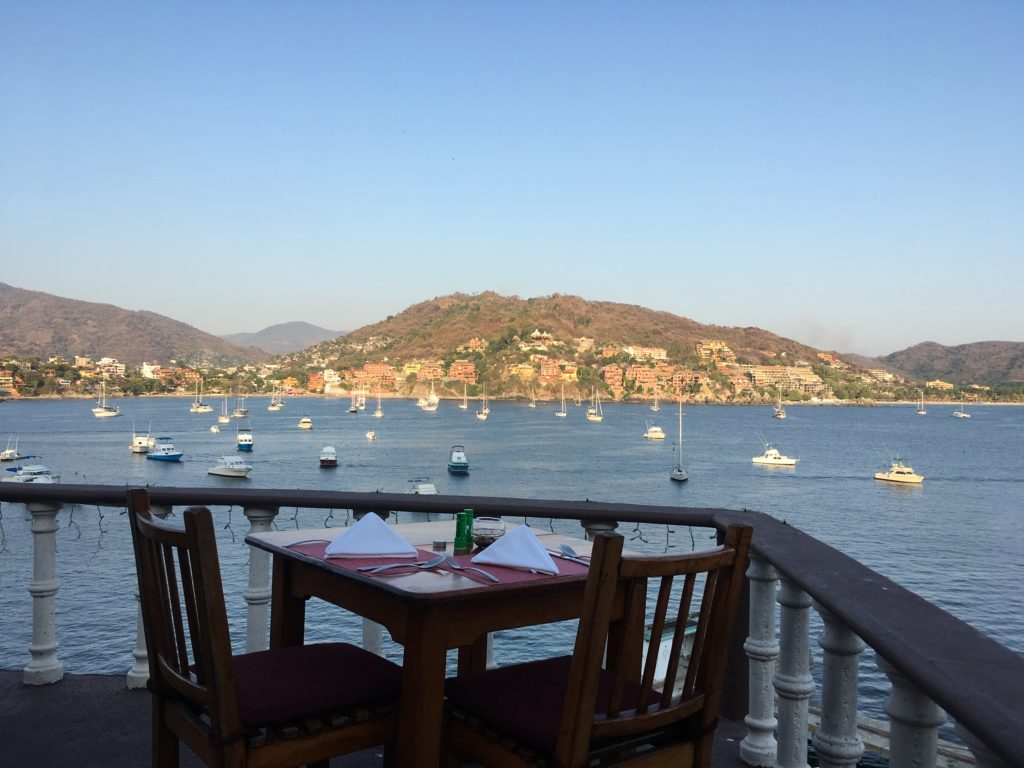
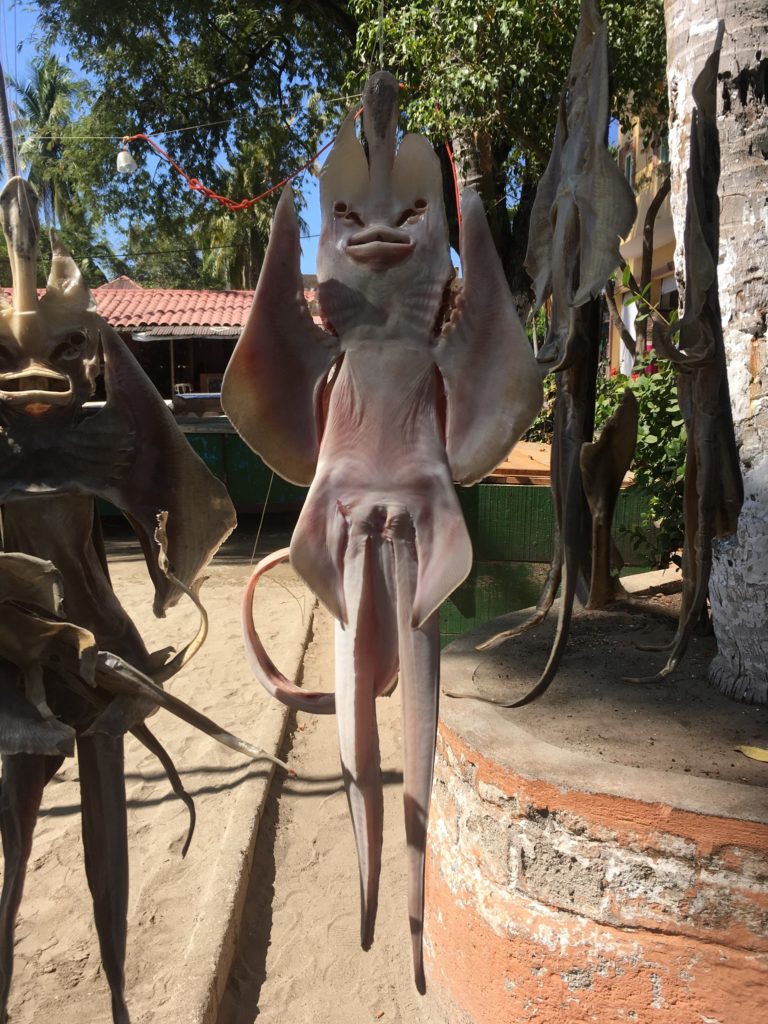
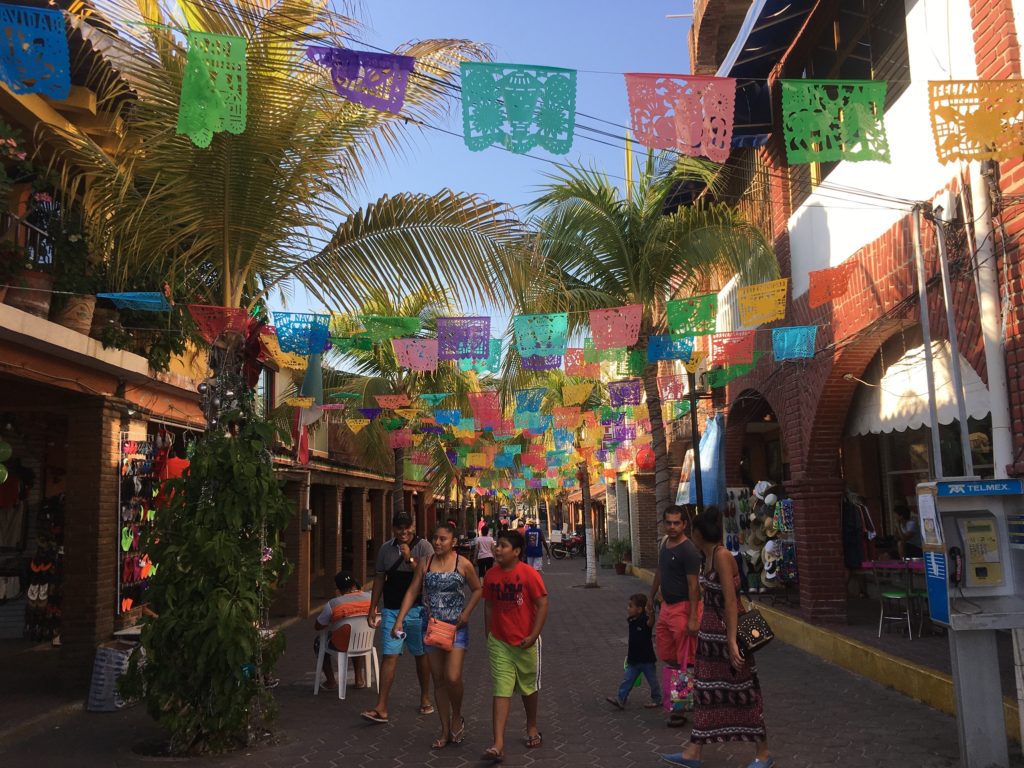
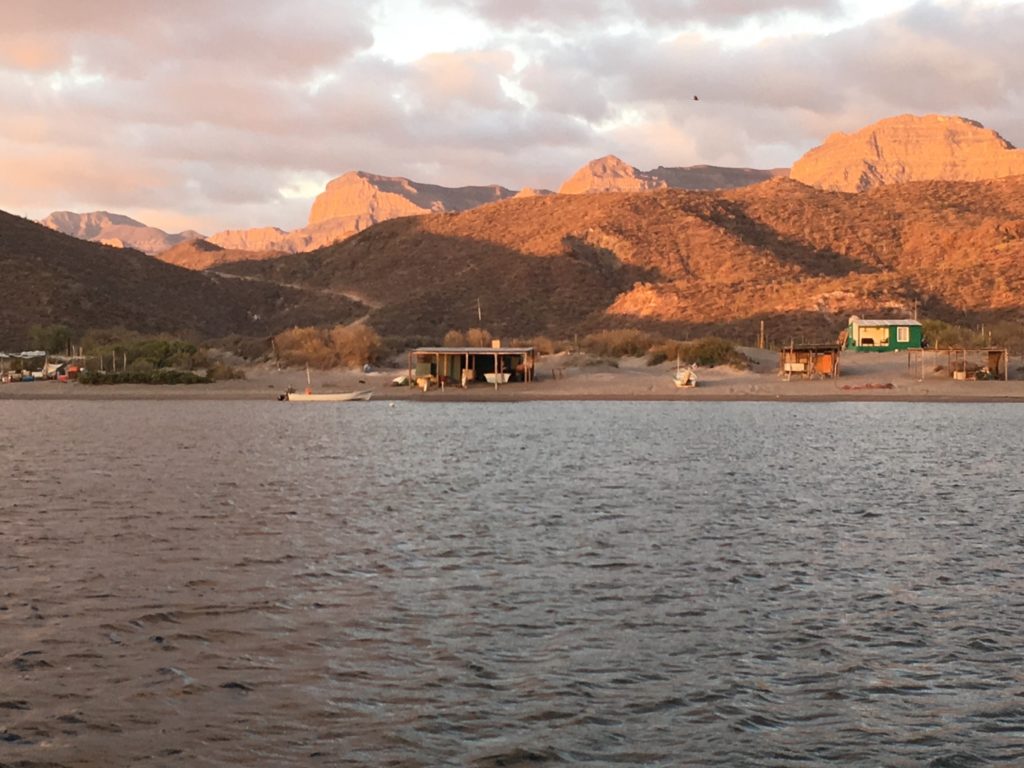

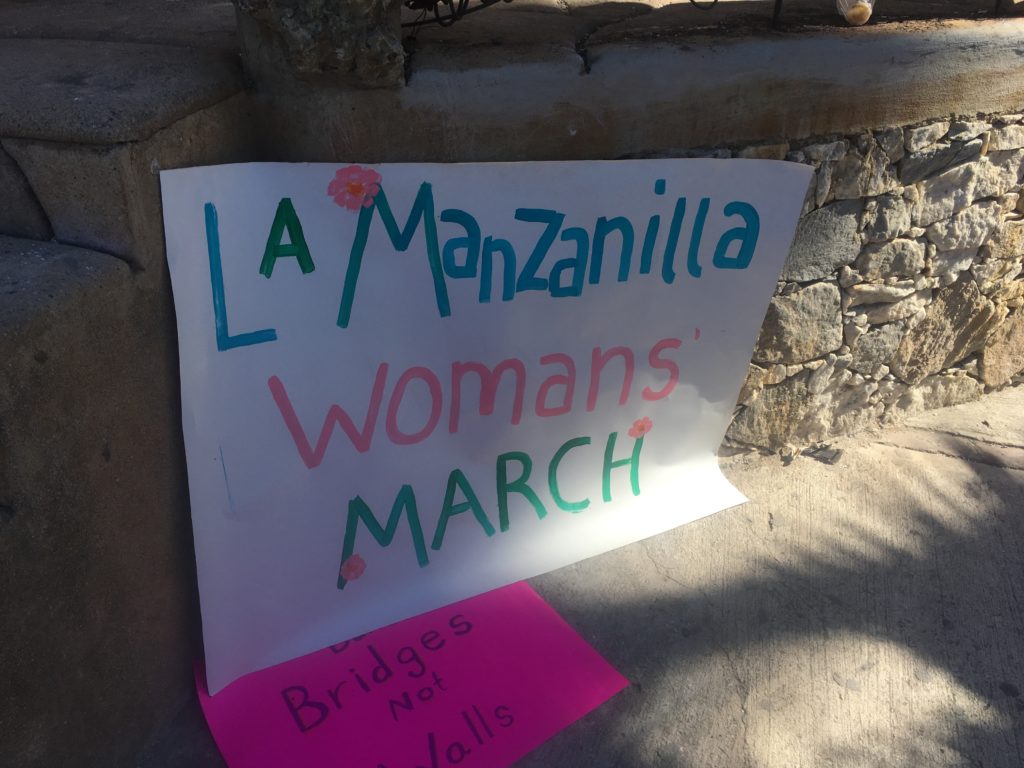

We thoroughly enjoyed reading the report on your 2017 sailing season in Mexico. You probably don’t remember me, but I chatted with Rick in the Hotel lobby of the Serenadad in Mulege. We were both trying to get internet service. I was traveling back from the NORRA Baja 1000 Off-Road Race with my husband and race team. What a peaceful hotel that is. Your adventures interested me. You gave me one of your cards so I decided today to look into what you were doing now. Great story and great photos.
Thanks for the sweet note. Glad to hear from you. Yes, we remember you. I am glad you enjoyed the blog. We wish you both well in your journeys.